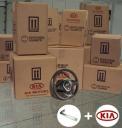
GM is contributing to the green contagion by designing 3 more concept mini cars to be put into production in the “relatively near future”.
Trying to make an impact in the small car market currently dominated by Japanese products, GM has created what they call The Triplets:Beat, Groove and Trax.
The “triplets,” as Lutz called them, include the Beat, a front-wheel drive three-door hatchback powered by a 1.2-liter turbocharged gasoline engine; the Groove, a retro looking front-wheel drive car with a 1-liter diesel engine; and the Trax an “urban crossover” with an all-wheel-drive system and a 1-liter gas engine.
(Source)
There is no reference to any special auto warranty or other incentives, but if you would like to offer your 2 cents on “The Triplets” before they hit production, you can render your opinion on the General Motors website.
As with so much else in today’s world, the Internet and advanced web applications have streamlined and eased the ways we do business and the costs therein.
The auto warranty business has also benefited by advances in software that has been created to enhance efficiency and accuracy, as demonstrated by Service Bench. What it means for the consumer is less delay, confusion and cost. ServiceBench allows “manufacturers … to reduce the cost of warranty without damaging service performance.”
“The solution both manages all warranty calls and issues for manufacturers and also allows partners such as retailers or extended warranty providers and their network of parts suppliers, distributors and service providers, to access data such as parts ordering information and to file claims for work done. Because it is all automated it speeds up the processes such as submitting a claim, its validation and then its settlement, and reduces waste. Special analytics software is also part of the application and allows managers to examine all aspects of a product’s lifecycle and the performance of its supply chain.
ServiceBench is one of the new breed of companies that offers its software as a service (SaaS) and the company’s president and chief executive officer Michael Dering said this makes the application well suited to its purpose. ‘As it is web based it offers easy but controlled access to the same data up through the supply chain and even to the user,’ he said. ‘Also we update the application every four weeks.’”
(Source)

Well, that’s not actually what they said, but some might conclude that this is taking self-help to an unknown degree of application. Build your own car? Well, that’s what Kia wants to offer their customers in the UK.
“Kia will become the first manufacturer to offer a self-build car for UK customers known as the Concept i Self-Build.
Buyers will be able to choose an engine, transmission and trim specification and specify a saloon, hatch, estate or pick-up.
Dealers will then supply the modules to the customer, along with a manual, presumably written in every language under the sun bar English.”
Not only will the customer be permitted to build his own vehicle but he will be granted an auto warranty based on his or her competency .
A selection of powertrains will be included, while a range of transmissions will be available, including a four-speed automatic and six-speed manual.
The rear module of the Concept I can be swapped for another at any time. Warranties will be awarded on the basis of the competence of the car builder. Paul Philpott says:
“A high score will get a seven year warranty, a low score about a couple of weeks.â€
An on-sale date and pricing are yet to be announced.
(source)

If you thought slow drivers made you mad before, wait until you get behind one of these. You’ll have to provide rear end propulsion yourself if you want to get this thing out of your way. This thing is, by the way , a Flybo-EV, another manifestation of green think.
“…the euphonically christened XFD-6000ZK, is one of three Flybo-EV models headed for the U.S. market. All are classed as LSVs/NEVs (Low Speed / Neighborhood Electric Vehicles), which means they’re limited to 25 mph (40 mph without the mechanical limiter) and needn’t be especially crashworthy. However, Flybo-EV North America assures us that they’re “100% legal for on-road use.”
I wonder if their auto warranty covers being zapped in a fly trap.

Personally, I’ve never seen a pothole big enough to fish in but it would be comparable to the hole in your wallet that most tire purchases create. When that new rubber bites into a pothole 6 months later,you’ll be wondering why you didn’t consider getting that Road Hazard warranty on your tires.
Manufacturers’ will warranty against defect,but, unfortunately, there is no auto warranty or tire warranty that will protect you against your town’s insufficient road repair budget. You have an auto warranty, give due thought to a road hazard warranty too.
“Most tires come with a warranty which covers workmanship and materials. In other words, the tire maufacterer covers things which are in their control, like defects. They are not interested in warranting the condition of the roads or your inability to hit debris.
This is where a Road Hazard warranty can save you money and aggravation. Road Hazard warranties are one of the best values, yet one of the most misunderstood benefits. Let’s start off by expalining exactly what is a Road Hazard warranties and how does it save me money?
Most Road Hazard warranties are set up to protect you, from paying full price, even if you happen to get a flat or even destroy a tire beyond repair. If you are fortunate enough to have purchased the warranty, you will only pay for the amount of tread that you used prior to the needed replacement. (This is called pro-rated).
Here is an example. Let’s say your tire is 1/2 way worn at the time of the flat. With tires averaging $100 each, your replacement cost would only be $50.00. Much better than full price, yes? Definitely – great value.
Typically, Road Hazard warranties will cover things like nails, glass, metal, stones etc. and almost anything else that could puncture or damage a tire. Some Road Hazrd packages provide a nationwide coverage, which are great for people who are traveling, or vacationing, because you now have peace of mind knowing that you are protected while away from your local area.
In addition, many Road Hazard warranties offer other benefits like free rotations and free balancing (check where you purchase your tires for all the details). Regular maintenance is the best way to extend the life of your tire and get as many miles as possible for your investment.”
from MyHonestMechanic/GeneGrant
 No matter what auto warranty covers your hybrid, the concept itself is not turning out to be the big money maker that foreign and domestic brands had imagined. Since there is no auto warranty that covers resale or secures a good return on the premium consumers pay for hybrids, you might want to re-think a hybrid purchase.
No matter what auto warranty covers your hybrid, the concept itself is not turning out to be the big money maker that foreign and domestic brands had imagined. Since there is no auto warranty that covers resale or secures a good return on the premium consumers pay for hybrids, you might want to re-think a hybrid purchase.
“A few years ago, automakers decided to put hybrid technology in regular models. The hope was to move beyond the geek chic of the Prius and win over everyone else. Hybrid would be another option, like , say, navigation. If enough people bought hybrids, carmakers figured, they would achieve sufficient economies of scale to eliminate the big premium over conventional models.
That hasn’t happened. And some models have suffered badly. Honda Motor Co. (NYSE:HMC – News) sold 70% fewer hybrid Accords in 2006; Toyota has sold 24% fewer Lexus RX 400h sport-utility vehicles so far this year. The fuel savings are simply too puny to offset the hybrid premium. With gas at $2.50 a gallon, it would take 10 years to recoup the extra $3,000 cost of the Accord hybrid.
[..]
Getting prices down–and not by discounting–is the long-term solution. That means finding a way to make the cars more cheaply. Batteries account for about half the hybrid premium. But cheaper lithium ion cells won’t appear for several years. Cutting costs further requires achieving those elusive economies of scale, which means building and selling more hybrids. That’s Toyota’s strategy; it hopes to sell 160,000 Priuses this year, up from 107,000 in 2006.”
(Source)








